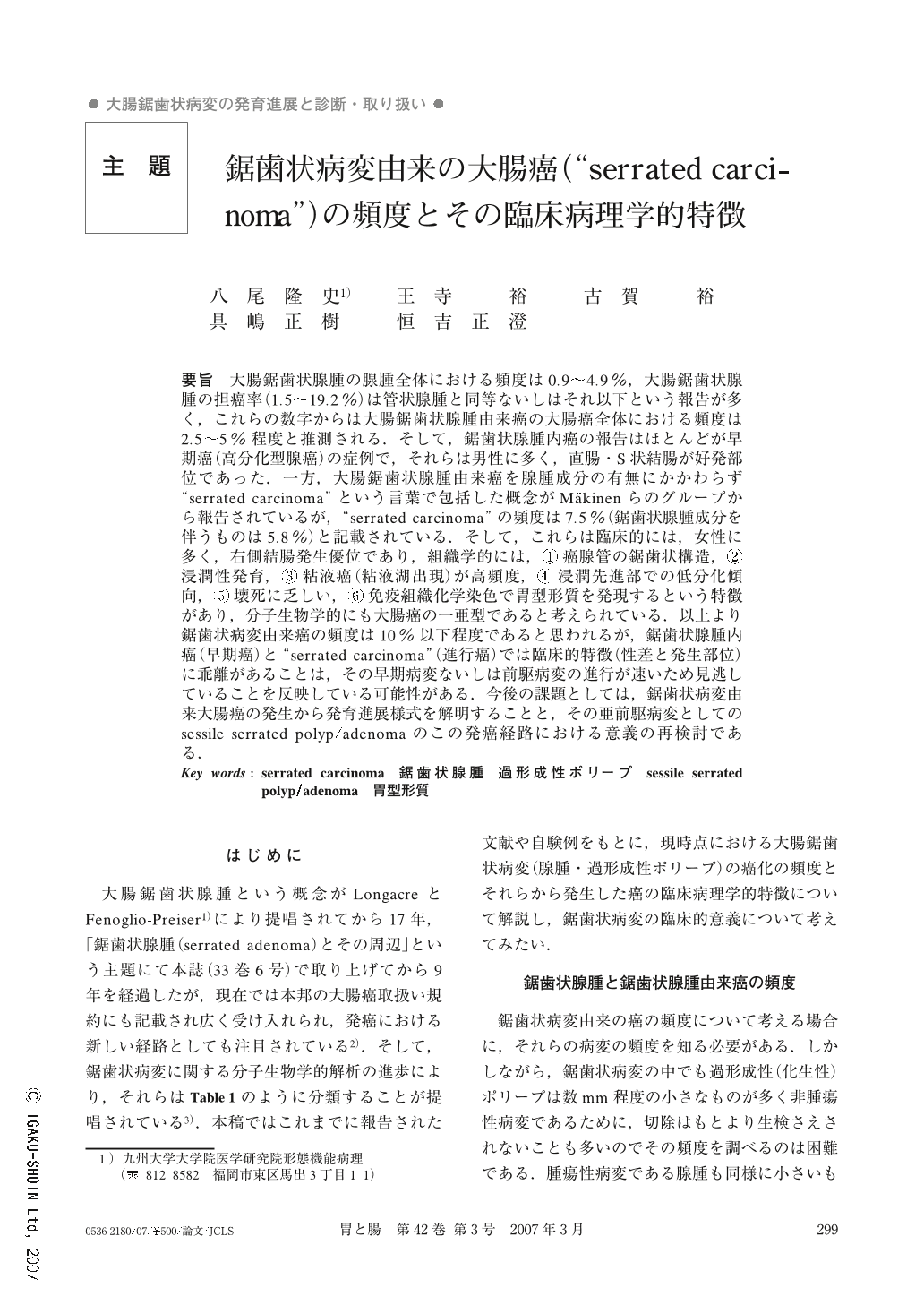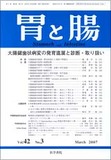Japanese
English
- 有料閲覧
- Abstract 文献概要
- 1ページ目 Look Inside
- 参考文献 Reference
- サイト内被引用 Cited by
要旨 大腸鋸歯状腺腫の腺腫全体における頻度は0.9~4.9%,大腸鋸歯状腺腫の担癌率(1.5~19.2%)は管状腺腫と同等ないしはそれ以下という報告が多く,これらの数字からは大腸鋸歯状腺腫由来癌の大腸癌全体における頻度は2.5~5%程度と推測される.そして,鋸歯状腺腫内癌の報告はほとんどが早期癌(高分化型腺癌)の症例で,それらは男性に多く,直腸・S状結腸が好発部位であった.一方,大腸鋸歯状腺腫由来癌を腺腫成分の有無にかかわらず"serrated carcinoma"という言葉で包括した概念がMäkinenらのグループから報告されているが,"serrated carcinoma"の頻度は7.5%(鋸歯状腺腫成分を伴うものは5.8%)と記載されている.そして,これらは臨床的には,女性に多く,右側結腸発生優位であり,組織学的には,①癌腺管の鋸歯状構造,②浸潤性発育,③粘液癌(粘液湖出現)が高頻度,④浸潤先進部での低分化傾向,⑤壊死に乏しい,⑥免疫組織化学染色で胃型形質を発現するという特徴があり,分子生物学的にも大腸癌の一亜型であると考えられている.以上より鋸歯状病変由来癌の頻度は10%以下程度であると思われるが,鋸歯状腺腫内癌(早期癌)と"serrated carcinoma"(進行癌)では臨床的特徴(性差と発生部位)に乖離があることは,その早期病変ないしは前駆病変の進行が速いため見逃していることを反映している可能性がある.今後の課題としては,鋸歯状病変由来大腸癌の発生から発育進展様式を解明することと,その亜前駆病変としてのsessile serrated polyp/adenomaのこの発癌経路における意義の再検討である.
The incidence of colorectal serrated adenoma has been reported to be 0.9 to 4.9%. The incidence of carcinoma in serrated adenoma has been reported to be equal to or lower than carcinoma in tubular adenoma (1.5 to 19.2%). From these reports, the incidence of carcinoma arising from serrated adenoma per total colorectal carcinoma is considered to be 2.5 to 5%. The most reported cases of carcinoma in serrated adenoma were intramucosal, well-differentiated adenocarcinoma, in which male sex and left-sided location were predominant.
On the other hand, a new concept of ‘serrated carcinoma' was proposed by Mäkinen, which included carcinomas with or without a serrated adenoma component. Its incidence was reported to be 7.5% of all colorectal carcinomas, and that of carcinomas with a serrated adenoma component was 5.8%. Clinicopathologically, female sex and right-sided location were predominant in ‘serrated carcinoma'. Its histological characteristics are as follows ; 1) serrated structure of carcinomatous glands, 2) infiltrative growth, 3) high incidence of mucinous carcinoma (or presence of mucin pools), 4) tendency to de-differentiation at the invasive front, 5) rare necrotic foci. In addition, it tended to express gastric-phenotype, and molecular events supported the supposition that it might be a subtype of colorectal carcinoma.
From the above reports, the incidence of carcinoma arising from serrated polyps is considered to be 10% at most. The differences in clinical background (especially in sex ratio and tumor location) may be due to overlooking the precursors or early lesions that grow into advanced carcinoma very quickly. Further study is needed for clarifying the natural history of serrated polyps and the significance of sessile serrated adenomas and hyperplastic polyps as precursors.

Copyright © 2007, Igaku-Shoin Ltd. All rights reserved.


